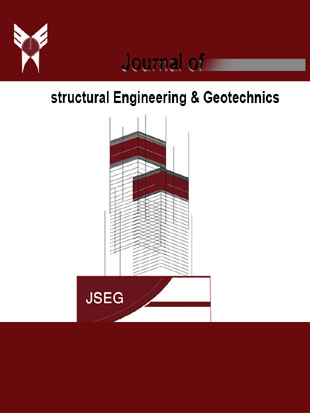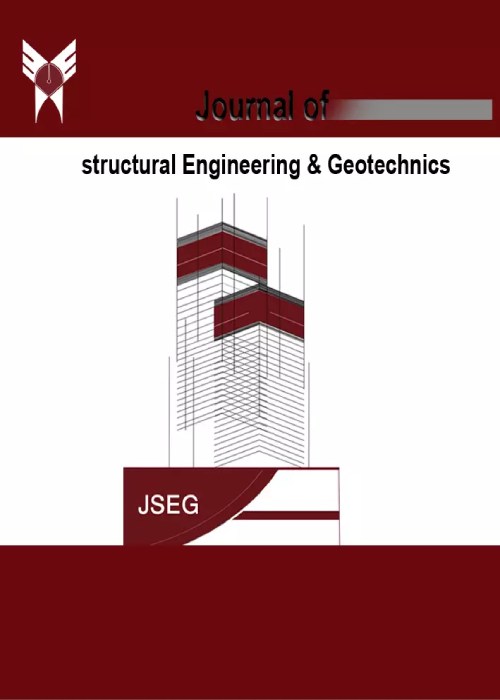فهرست مطالب

Journal of the Structural Engineering and Geotechnics
Volume:2 Issue: 1, Winter 2012
- تاریخ انتشار: 1391/10/28
- تعداد عناوین: 8
-
Pages 1-11The aim of the present paper is to evaluate the influence of the Soil- Foundation- Structure Interaction (SFSI) effects on the component demand modifier factor of concrete gravity beams based on ASCE 41-06 standard. To this end، the beam on the nonlinear Winkler foundation approach is employed which is a simple and efficient method. At first، four sets of 3-، 6-، 10- and 15-storey concrete moment-resisting frames founded on soft، medium and hard soils are designed and analysed for the case of fixed-base and flexible-base assumptions. A comparison is then made between the results of the nonlinear response history analysis of each frame in the flexible-base and fixed-base conditions with the response based on the equivalent linear static approach. The findings show that the equivalent linear static approach loads for gravity beams، which are controlled by deformation actions، can lead to non-conservative predictions of seismic demand. Finally، a modified load combination is proposed to be used in the equivalent linear static approach to avoid this imperfection.Keywords: CE Database subject headings, Winkler spring, Soil, Foundation, Structure Interaction, ASCE 41, 06 standard, Nonlinear seismic response history analysis, Ground motion
-
Pages 13-17There is a worldwide interest in using fibers of different types in concrete mixtures. In this regard, as the use of PET fibers has gradually increased during the last decade, this study aims to investigate the effects of PET fibers on the mechanical properties of hardened concrete and the workability of fresh concrete. To this end, different contents of PET fibers (PC= %0, %0.5, %1 and %1.5) are added to a concrete mixture and the workability of fresh concrete samples are measured by the slump tests. Furthermore, the load-displacement behavior of the concrete samples is investigated in flexural and compression samples. Results of this study reveal that PET fibers can noticeably change the energy absorption of concrete samples, especially in flexural specimens.Keywords: Fiber reinforced concrete, PET fiber, Concrete workability, Mechanical properties
-
Pages 19-28This paper consists of three sections. In the first section an efficient method is used for decomposition of the canonical matrices associated with repetitive structures. to this end, cylindrical coordinate system, as well as a special numbering scheme were employed. In the second section, divide and conquer method have been used for eigensolution of these structures, where the matrices are in the block tri-diagonal form. In the third section a comparison of the results is presented. In order to illustrate the efficiency of the aforementioned methods, repetitive structures are considered in the form of barrel vault space structures.Keywords: Space structures (barrel vaults), Factor analysis, Eigenvalues, Eigenfunctions, Vibration
-
Pages 29-41The liquefaction resistance of soil can be evaluated using laboratory tests such as cyclic simple shear, cyclic triaxial, cyclic torsional shear as well as field methods like Standard Penetration Test (SPT), Cone Penetration Test (CPT) and Shear Wave Velocity (Vs). In this regard, this study attempts to compare the results of the SPT based on the simplified procedure proposed by Seed and Idriss (1985) and those of the Vs on the basis of Andrus et al.’s (2004) process using empirical relationships between them. Iwasaki’s (1982) method is used to measure the liquefaction potential index for both of them. The study area is a part of the south and southeast of Tehran. It is observed that there is not a perfect agreement between the results of the two methods based on five empirical relationships assuming cemented and non-cemented condition for soils. Moreover, the liquefaction potential index (PL) value in the SPT method is more than that of the Vs method.Keywords: Standard Penetration Test (SPT), Shear Wave Velocity (Vs), Liquefaction Potential Index (PL), South of Tehran
-
Pages 43-47Buckle folds are common traps for hydrocarbon in several contractional provinces. Buckle folds form where stratified sequences rest a top salt or some other utterly weak rock as a decollemet zone in units with high competency contrasts by a compressive stress which acted along the length of the rock layers. An important parameter affecting buckle folding of a competent zone above a mobile decollement is existence of a thick lower decollemet. In this paper the effect of detachment zone on folding of rock layers is studied using finite element method. Large deformation formulation is considered. Mohr-Coulomb plasticity model is used to deal with nonlinearity of material during folding. Two cases of folding are considered. In the first case a symmetric fold with equal detachment thickness beneath two flanks is analyzed. In the second case detachment zone is omitted in one flank. Finally, the effect of detachment zone on folding and deformed shape of buckle fold is studied.Keywords: Buckle folds, Numerical modeling, Finite element method, Detachment zone, Folding
-
Pages 49-54In this study, the feasibility of using magnetic technology to reduce the dispersion of soil has been investigated. The reference treatment was potable water and 3 magnetic water devices (with different magnetic intensities) were used for magnetizing the potable water. The results showed that the magnetic field has a significant effect in order of 5 percent on increasing of magnesium concentration in soil columns and the calcium concentration in magnetic treatment was more than the reference treatment. It seemed that improving in hydrogen bonding between water molecules and clay particles and water trapping in soil caused reduction of salt in the soil. According to the increase of calcium and magnesium bivalent Cations in the soil, it is suggested that the use of magnetic field could improve soil’s dispersion and decrease the degree of soil’s dispersion.Keywords: Dispersive soil, Magnetic field, cations movement, Water
-
Pages 55-59Cylindrical steel tanks are important components of many industrial plants such as oil refineries and chemical plants. Usually failure of cylindrical tanks leads to serious consequences. During the past earthquakes such as 1964 Alaska and 1999 Turkey seismic performance of cylindrical tanks revealed that tanks are seismically vulnerable. Therefore, evaluation of seismic performance of these structures is an important task in seismic prone areas. During an earthquake, a sloshing motion may occur in upper parts of the liquid. In storage tanks during earthquake if fluid wave height in tank increases, the fluid wave may damage the roof or some parts of roof holders. The tanks should resist against unfavourable impacts such as earthquakes. In this paper, 5 tanks with different H/D ratios in an oil refinery complex in Iran were studied using static and dynamical analysis (linear and non-linear). Spectrum and time history linear and non-linear analysis was completed in order to find the fluid wave height and also ratio of wave height to the tank diameter.Keywords: Seismic Sloshing Wave, Vulnerability, Cylindrical Tanks, Fluid Wave Height, H, D Ratio
-
Pages 61-66Performance of structures during recent earthquakes shows that the effect of vertical component of earthquake (VCE) could be considered as one of the main causes of bridges collapse. In most of bridge design codes, for seismic analysis of bridges, VCE is not taken into account or a distinguished method isn’t presented for assessment of VCE. In the present work, the effect of VCE on two existing bridges, one with continuous deck and the other with monolithic frame system, was studied. The first model consisted of a pre-stress bridge in which the superstructure was connected rigidly to piers. The super structure consisted of 3 spans with length of 16, 48 and 16 m. The end of side slabs was put on abutments. The second model was a bridge with steel deck and concrete piers. The bridge superstructure was composed of I girder beams and in-place concrete slab. The beams were placed on 3 piers located 24 m far from each other, continually. In both models, the effect of VCE was studied considering the 3 acceleration of Tabas, Northridge and Kobe earthquakes and using linear and nonlinear time history and spectrum analysis on 3D models. In each analysis, the model was analyzed considering the 3 component and 2 horizontal components of earthquakes separately. The ratio of the difference of results in two analyses to the result of bridge response under its weight (DL) was compared. Through this method the amount of VCE effect on affected elements (according to statistical system of bridge) was found out.Keywords: Monolithic bridge, Continuous frame, Earthquake, Vertical component


